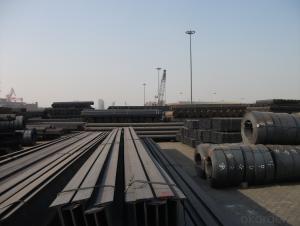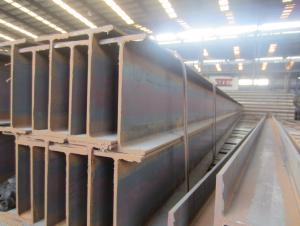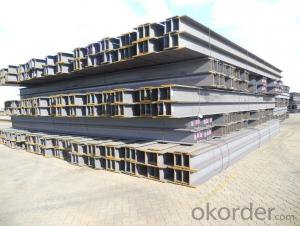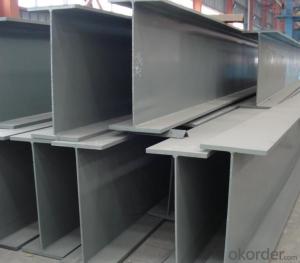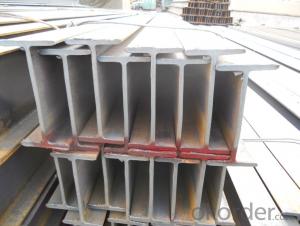Alloyed Hot rolled I beams/Ibeams GB standard/JIS standard
- Loading Port:
- Tianjin
- Payment Terms:
- TT OR LC
- Min Order Qty:
- 50 m.t.
- Supply Capability:
- 1500 m.t./month
OKorder Service Pledge
OKorder Financial Service
You Might Also Like
Packaging & Delivery
Packaging Detail:packed in bundle, suitable for sea transport (by container) or According to the clients`requirements
Delivery Detail:According to the actual weight
Specifications
joist steel
high quality and factory price
large inventories
short delievery time
good after-sales service
Country of Origin: China
Mill name: Ningbo Preah Vihear Steel Industry Co., Ltd.
Commodity: H beam
Tolerance: Strictly according to the G/B and JIS standard
Delivery time: within 30days
Price term: CIF/ CFR according to clients requirements
Payment terms: 100%Irrevercable L/C At Sight or TT
Product Description
ACCORDING TO STANDARD: JIS G3192 OR GB/T11263-2005
H beam Section sizenma(mm)Weight (kg/m)
Height×BreadthWeb thichnessFlange thichness
100×1006816.9
125×1256.5923.6
150×15071031.1
175×1757.51140.4
200×20081249.9
250×25091471.8
300×300101593.0
300×3001515105.0
350×3501219134.9
400×4001321171.7
148×1006920.7
194×1506929.9
244×17571143.6
294×20081255.8
340×25091478.1
390×3001016104.6
440×3001118120.8
482×3001115110.8
488×3001118124.9
582×3001217132.8
588×3001220147.0
100×50579.3
125×606813.1
150×755714.0
175×905818.0
198×994.5717.8
200×1005.5820.9
248×1245825.1
250×1256929.0
298×1495.5832.0
300×1506.5936.7
346×1746941.2
350×17571149.4
396×19971156.1
400×20081365.4
446×19981265.1
450×20091474.9
496×19991477.9
500×200101688.1
596×199101592.4
600×2001117103.4
700×3001324181.8
800×3001426206.8
900×3001628240.1
- Q:How are steel H-beams manufactured?
- Steel H-beams are manufactured through a process called hot rolling, where molten steel is poured into molds and then passed through a series of rollers to shape it into the desired H-beam profile. The heat and pressure applied during hot rolling help to achieve the required strength and structural integrity of the beams. After the hot rolling process, the H-beams are further cooled, cut to the desired length, and undergo various quality checks before being ready for use in construction projects.
- Q:Can steel H-beams be used in the construction of sports arenas?
- Sports arenas can indeed utilize steel H-beams for construction purposes. These H-beams possess numerous benefits that render them suitable for this particular type of edifice. First and foremost, H-beams boast exceptional strength and durability, enabling them to bear the immense weight of expansive roof structures, seating areas, and other substantial loads commonly found in sports arenas. Moreover, steel H-beams exhibit a high resistance to corrosion, which proves essential in structures that are constantly exposed to diverse weather conditions. Furthermore, the versatility of steel permits the fabrication of H-beams in various sizes and shapes, guaranteeing that they can be customized to meet the precise design requirements of sports arenas. In conclusion, the utilization of steel H-beams in the construction of sports arenas ensures the creation of a secure and sturdy structure that can withstand the demands of accommodating large crowds and supporting intricate roof systems.
- Q:Can steel H-beams be used in temporary supports during construction?
- Yes, steel H-beams can be used in temporary supports during construction. Steel H-beams are commonly used in construction due to their high strength and durability. They are designed to withstand heavy loads and provide the necessary support for various structures. Temporary supports are often required during construction to provide stability and prevent collapse. Steel H-beams can be easily installed and adjusted as needed, making them an ideal choice for temporary supports. Additionally, their versatility allows for use in various construction projects, ranging from smaller residential buildings to large infrastructure projects. Overall, steel H-beams are an effective and reliable option for temporary supports during construction.
- Q:What is the difference between hot-rolled and cold-formed steel H-beams?
- H-beams made of steel can be produced using two different methods: hot-rolling and cold-forming. These methods result in H-shaped cross-section beams that have distinct characteristics. Hot-rolled steel H-beams are created by heating a large steel billet or ingot to extremely high temperatures and then shaping it through rolling. This process involves intense heat, making the steel more malleable and easier to shape. As a result, the finished product has a rougher surface texture. Hot-rolled H-beams typically have wider flanges and thicker webs compared to cold-formed H-beams. They are commonly used in heavy-duty construction projects that require high strength and load-bearing capacity. On the other hand, cold-formed steel H-beams are manufactured by shaping cold-rolled or galvanized steel coils into the desired H-shaped profile. This process takes place at room temperature, without the use of heat. Cold-formed H-beams have a smoother surface finish and more precise dimensions compared to hot-rolled beams. They also tend to have thinner flanges and webs, making them lighter and more suitable for applications where weight reduction is important. Cold-formed H-beams are commonly used in light to medium-duty construction, such as residential buildings and infrastructure projects. In terms of mechanical properties, hot-rolled H-beams generally have higher yield and tensile strength compared to cold-formed H-beams. This is because the intense heat during the hot-rolling process allows the steel to undergo grain refinement and achieve better mechanical properties. On the other hand, cold-formed H-beams usually have lower strength but higher ductility and toughness. They can deform more before failure, making them more resistant to bending and deformation. In summary, the main differences between hot-rolled and cold-formed steel H-beams lie in the production process, surface finish, dimensions, and mechanical properties. Hot-rolled beams are produced at high temperatures, have a rougher surface, and are used in heavy-duty construction. Cold-formed beams are manufactured at room temperature, have a smoother surface, and are suitable for lighter construction applications.
- Q:What are the considerations when designing for natural disaster planning in Steel H-Beams?
- There are several important factors to consider when designing Steel H-Beams for natural disaster planning. Firstly, it is crucial to ensure that the H-Beams have sufficient load-bearing capacity to withstand the forces exerted during a natural disaster. This involves calculating the maximum expected loads and stresses that the beams may experience and designing them to safely handle these forces. The choice of materials for the H-Beams is also crucial in natural disaster planning. Steel is often preferred due to its high strength and durability. The steel used should possess appropriate mechanical properties, such as high tensile strength and ductility, to withstand the dynamic forces associated with natural disasters. Compliance with relevant design codes and standards is essential to ensure the structural integrity of the H-Beams. These codes provide guidelines on factors such as minimum safety factors, design loads, and construction practices specific to natural disaster-prone areas. Incorporating redundancy into the design is important to enhance the resilience of the structure. This can be achieved by providing additional beams or bracing elements to distribute the loads more evenly and prevent the collapse of the entire structure in case of localized failures. If the natural disaster being planned for is an earthquake, additional seismic considerations need to be taken into account. This includes designing the H-Beams to withstand the ground motion induced by earthquakes and incorporating seismic isolation or energy dissipation devices to reduce the impact of seismic forces on the structure. The connection details between the H-Beams and other structural elements are critical for overall structural stability. These connections should be designed to resist the anticipated forces and moments and maintain their integrity during a natural disaster. Considerations for ease of construction and maintenance should also be incorporated into the design. This includes ensuring that the H-Beams can be installed and maintained easily, as well as providing provisions for regular inspections and repairs to maintain their structural integrity over time. By carefully considering these factors, designers can create H-Beam structures that are resilient and capable of withstanding the forces imposed by natural disasters, thereby ensuring the safety of the occupants and minimizing damage to the overall infrastructure.
- Q:Can steel H-beams be used for observation towers?
- Yes, steel H-beams can be used for observation towers. Steel H-beams are commonly used in the construction industry for their strength and durability. They provide excellent structural support and can withstand heavy loads, making them suitable for tall structures like observation towers. Additionally, steel is a versatile material that can be easily shaped and welded to meet specific design requirements. Therefore, steel H-beams are a popular choice for observation tower construction due to their strength, durability, and ability to provide a stable and secure structure for observing the surrounding area.
- Q:Can steel H-beams be used for roof support?
- Yes, steel H-beams can be used for roof support. Steel H-beams are commonly used in construction as they offer great strength and load-bearing capabilities. They are often used to support the weight of roofs, as well as other structural elements in buildings.
- Q:Can steel H-beams be used in the construction of shopping malls?
- Certainly, shopping malls can utilize steel H-beams for construction purposes. Due to their robustness and endurance, steel H-beams are frequently employed within the construction sector. They deliver crucial support to structures and are commonly employed in the erection of extensive edifices, such as shopping malls. Being capable of enduring substantial weights and offering stability, steel H-beams prove to be an excellent option for constructing the framework of shopping malls. Furthermore, steel is an environmentally friendly and cost-efficient material, making it highly favored in commercial construction ventures.
- Q:How do Steel H-Beams perform in seismic or high-wind conditions?
- Steel H-Beams are known for their excellent performance in seismic or high-wind conditions. Due to their strong structural integrity and flexibility, they can effectively absorb and distribute forces generated by earthquakes or strong winds. This makes them highly resistant to damage and deformation, ensuring the safety and stability of buildings and structures in such conditions.
- Q:Can steel H-beams be used in industrial buildings?
- Yes, steel H-beams are commonly used in industrial buildings due to their strength, durability, and versatility. They provide excellent structural support and can withstand heavy loads, making them ideal for large-scale industrial construction projects.
1. Manufacturer Overview |
|
|---|---|
| Location | |
| Year Established | |
| Annual Output Value | |
| Main Markets | |
| Company Certifications | |
2. Manufacturer Certificates |
|
|---|---|
| a) Certification Name | |
| Range | |
| Reference | |
| Validity Period | |
3. Manufacturer Capability |
|
|---|---|
| a)Trade Capacity | |
| Nearest Port | |
| Export Percentage | |
| No.of Employees in Trade Department | |
| Language Spoken: | |
| b)Factory Information | |
| Factory Size: | |
| No. of Production Lines | |
| Contract Manufacturing | |
| Product Price Range | |
Send your message to us
Alloyed Hot rolled I beams/Ibeams GB standard/JIS standard
- Loading Port:
- Tianjin
- Payment Terms:
- TT OR LC
- Min Order Qty:
- 50 m.t.
- Supply Capability:
- 1500 m.t./month
OKorder Service Pledge
OKorder Financial Service
Similar products
New products
Hot products
Related keywords
